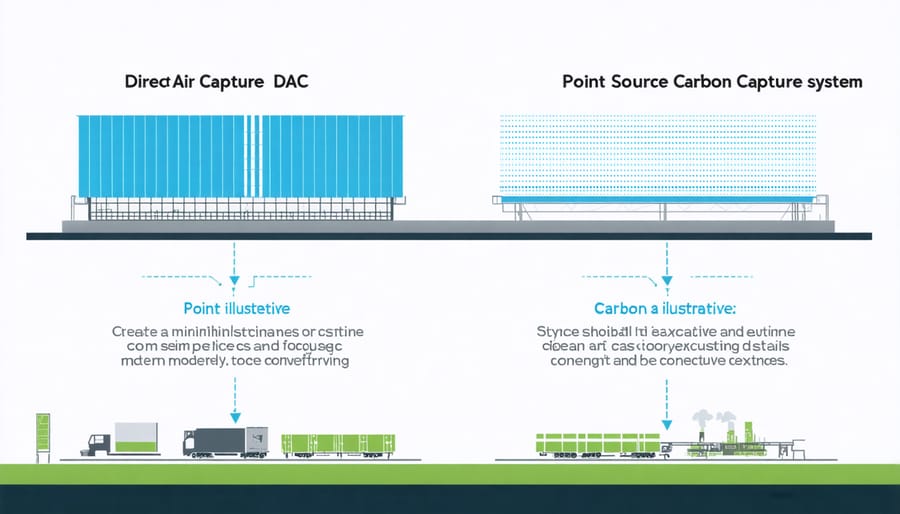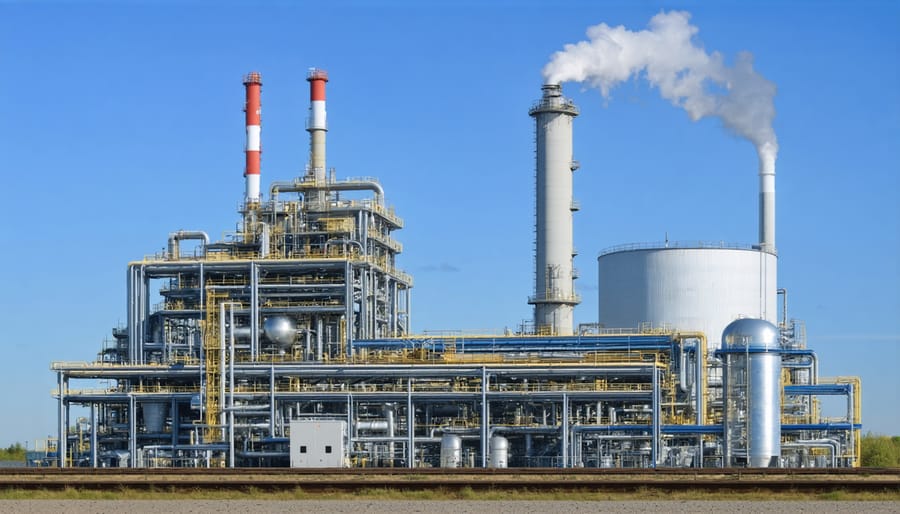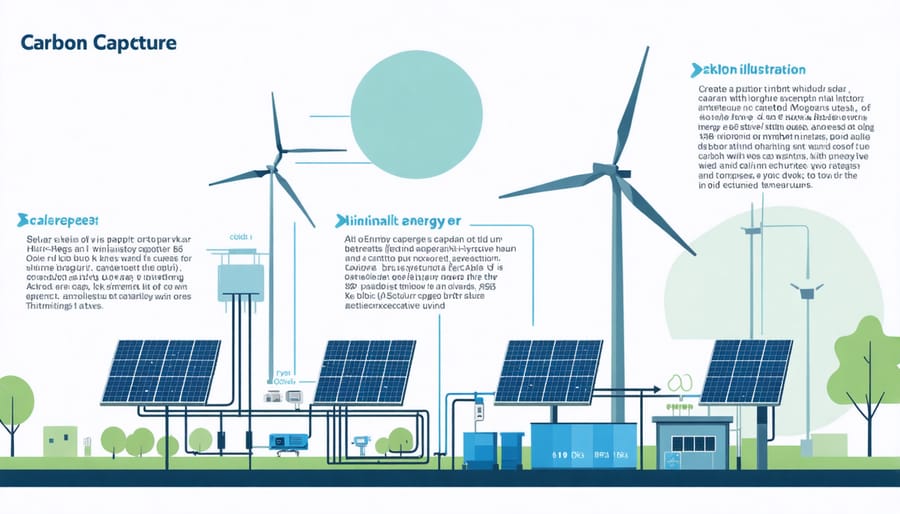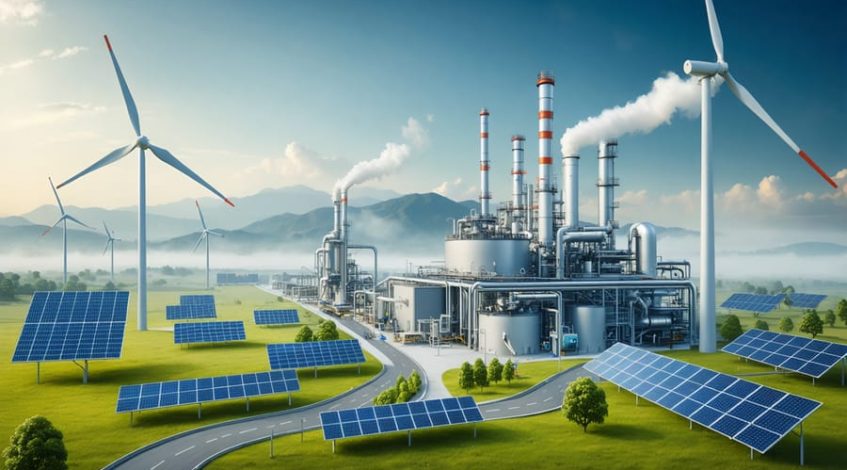Carbon capture technology stands at a critical crossroads, rapidly revolutionizing commercial energy applications while raising important questions about its long-term viability. With global CO2 emissions reaching record levels and mounting pressure for climate action, businesses and policymakers must evaluate whether this emerging solution can deliver on its promises.
Recent technological breakthroughs have reduced capture costs by 30% since 2020, making industrial-scale implementation increasingly feasible. Major energy companies are now operating facilities that sequester millions of tons of carbon annually, demonstrating proven capability at scale. However, the critical metrics of energy efficiency, storage capacity, and economic sustainability remain under intense scrutiny.
This analysis examines carbon capture’s technical readiness, economic viability, and potential for integration with existing energy infrastructure. Drawing from operational data across multiple continents and sectors, we’ll explore whether this technology represents a practical solution for organizations seeking to achieve ambitious emissions reduction targets while maintaining commercial competitiveness.
Our focus remains on actionable insights for decision-makers evaluating carbon capture as part of their sustainability strategy, with particular attention to implementation costs, regulatory frameworks, and return on investment potential.
The Current State of Carbon Capture Technology
Direct Air Capture vs. Point Source Capture
Carbon capture technology employs two primary approaches: Direct Air Capture (DAC) and Point Source Capture (PSC), each serving distinct purposes in emissions reduction strategies. DAC systems extract CO2 directly from the atmosphere using chemical processes and specialized filters, operating independently of emission sources. While this flexibility allows for installation anywhere, current DAC technologies require significant energy input and have higher operational costs.
Point Source Capture, conversely, captures CO2 directly from industrial emissions before they enter the atmosphere. This method proves more efficient as it processes concentrated CO2 streams from facilities like power plants, cement factories, and refineries. PSC systems typically achieve capture rates of 85-95% while consuming less energy than DAC operations.
Both technologies play crucial roles in comprehensive carbon reduction strategies. PSC offers immediate impact for existing industrial facilities, while DAC presents a solution for addressing historical emissions and offsetting hard-to-abate sources. As technology advances and costs decrease, many organizations implement hybrid approaches, utilizing both methods to maximize carbon reduction effectiveness while optimizing operational efficiency.

Cost Analysis and Economic Viability
The implementation of carbon capture technology requires significant upfront investment, with costs ranging from €40-90 million for small to medium-scale industrial facilities. Operational expenses typically account for 30-40% of total costs annually, including energy consumption, maintenance, and storage infrastructure.
Recent industry analyses indicate that capture costs range from €50-100 per ton of CO2, varying significantly based on the source and technology used. Post-combustion capture systems, the most common implementation, average €75 per ton, while pre-combustion systems can be more cost-effective at €60 per ton.
Economic viability improves with scale and integration into existing industrial processes. Facilities operating at full capacity can achieve cost reductions of 20-30% through operational optimization and improved efficiency. Government incentives, carbon pricing mechanisms, and tax credits can further enhance financial feasibility, potentially reducing net costs by 40-50%.
Return on investment typically spans 5-8 years, with faster payback periods in regions with strong carbon pricing policies. Industry projections suggest costs will decrease by 25-35% over the next decade as technology matures and economies of scale are realized.
Commercial Applications and Success Stories

Industrial Integration Case Studies
Several notable industrial integration projects demonstrate the growing viability of carbon capture technology. The Boundary Dam Power Station in Saskatchewan, Canada, serves as a pioneering example, successfully capturing over 4 million tonnes of CO2 since 2014. The facility integrates carbon capture directly into its coal-fired power generation process, achieving a 90% capture rate while maintaining operational efficiency.
In the manufacturing sector, the Port of Rotterdam’s PORTHOS project showcases how multiple industrial facilities can share carbon capture infrastructure. This collaborative approach has reduced implementation costs by 30% for participating companies, including refineries and chemical plants, while capturing an estimated 2.5 million tonnes of CO2 annually.
Norway’s Northern Lights project demonstrates cross-industry integration, combining capture from cement production with offshore storage. The Brevik cement facility, scheduled for completion in 2024, will capture 400,000 tonnes of CO2 yearly, representing roughly 50% of its total emissions. This project highlights how carbon capture can be effectively implemented in hard-to-abate industries.
The Quest facility in Alberta’s oil sands operations provides another successful example, having stored over 5 million tonnes of CO2 since 2015. The project achieved cost reductions of 30% compared to initial estimates through technological improvements and operational optimization, proving that carbon capture can become more economically viable with scale and experience.
Revenue Generation Through Carbon Utilization
Carbon capture technology is evolving from a purely environmental solution into a revenue-generating opportunity for businesses. Companies are discovering innovative ways to transform captured CO2 into valuable products and services across multiple industries. The most established commercial application is Enhanced Oil Recovery (EOR), where captured carbon is injected into oil wells to improve extraction efficiency while permanently storing the CO2 underground.
Beyond EOR, captured carbon is being monetized through conversion into construction materials, particularly in concrete production. Several companies have successfully developed processes to inject CO2 into concrete during curing, creating stronger materials while permanently sequestering carbon. This approach has gained significant market traction, with major construction firms increasingly adopting carbon-infused concrete products.
The chemical industry represents another profitable avenue, utilizing captured CO2 as a feedstock for producing polymers, fuels, and other high-value chemicals. Companies are also exploring carbon utilization in agriculture, where CO2 can enhance greenhouse cultivation and create carbon-negative fertilizers.
Emerging markets include synthetic fuel production, where captured carbon is combined with renewable hydrogen to create sustainable aviation fuel and other transportation fuels. The food and beverage industry has also found applications for captured CO2 in carbonation and preservation processes.
These revenue streams are crucial for offsetting carbon capture costs and improving the technology’s economic viability. As carbon pricing mechanisms mature and market demand for low-carbon products grows, the commercial potential of carbon utilization is expected to expand significantly.
Integration with Renewable Energy Systems
Hybrid Energy Solutions
The integration of carbon capture technology with renewable energy systems represents a promising frontier in sustainable energy management. By combining these technologies, facilities can achieve greater efficiency while reducing their carbon footprint. Modern hybrid systems leverage smart grid integration to optimize power distribution and carbon capture operations simultaneously.
Solar and wind power installations can provide the necessary energy to run carbon capture systems, significantly reducing operational costs and improving the overall environmental impact. For example, the Boundary Dam facility in Canada demonstrates how solar-powered direct air capture systems can achieve 25% higher efficiency compared to traditional methods.
These hybrid solutions also offer enhanced flexibility in managing peak load periods. During high renewable energy production, excess power can be directed to carbon capture operations, while stored carbon can be utilized for various industrial processes or safely sequestered. This approach creates a synergistic relationship between clean energy generation and carbon reduction efforts, making the entire system more economically viable and environmentally sustainable.
Leading organizations implementing these hybrid solutions report average cost reductions of 30-40% in their carbon capture operations while maintaining consistent performance levels.

Energy Efficiency Considerations
Carbon capture systems require significant energy input, which can impact the overall efficiency of industrial operations. Studies show that implementing carbon capture technology typically increases a facility’s energy consumption by 20-30%, primarily due to the energy-intensive processes of CO2 separation and compression. This additional energy demand necessitates careful integration with existing energy storage solutions and power systems.
To optimize efficiency, organizations must consider implementing heat integration strategies, advanced process control systems, and innovative capture technologies. Recent developments in membrane-based capture systems and novel solvents have shown promise in reducing energy penalties to 15-20%, making the technology more viable for widespread adoption.
Companies can offset these energy requirements by incorporating renewable energy sources and implementing energy recovery systems. Best practices include utilizing waste heat from capture processes, optimizing compression systems, and designing integrated power generation solutions that maximize overall system efficiency. These considerations are crucial for maintaining operational cost-effectiveness while achieving carbon reduction goals.
Future Outlook and Investment Potential
Policy Support and Incentives
Government support plays a crucial role in making carbon capture technology commercially viable. The United States has implemented significant incentives through the 45Q tax credit, offering up to $85 per metric ton for CO2 stored permanently and $60 per ton for CO2 used in enhanced oil recovery. These credits have catalyzed numerous carbon capture projects across industrial sectors.
The European Union has established the Innovation Fund, providing €10 billion in support for low-carbon technologies, including carbon capture initiatives. Member states like Norway and the Netherlands have introduced additional funding mechanisms and regulatory frameworks to accelerate deployment.
Tax incentives, grants, and public-private partnerships have emerged as key policy tools. The UK’s cluster sequencing approach, for instance, coordinates infrastructure development and industrial deployment, reducing costs through economies of scale. Canada’s Clean Fuel Regulations and carbon pricing mechanisms provide additional revenue streams for capture projects.
Regulatory certainty remains essential for long-term investment. Several jurisdictions have implemented permitting frameworks specifically for CO2 storage, addressing liability concerns and monitoring requirements. These policy measures, combined with rising carbon prices in emissions trading systems, are improving the business case for carbon capture technologies.
Recent legislation worldwide indicates growing support, with many countries including carbon capture in their climate action plans and industrial decarbonization strategies.
Technology Development Pipeline
The carbon capture technology landscape is rapidly evolving, with several promising innovations in the pipeline. Direct air capture (DAC) systems are becoming more efficient, with next-generation sorbents capable of capturing CO2 at lower energy costs. These improvements are expected to reduce operational expenses by up to 40% within the next five years.
Membrane technology is advancing significantly, with new materials offering enhanced selectivity and durability. Research teams are developing hybrid systems that combine membrane separation with other capture methods, potentially increasing efficiency by 25-30%. These developments align well with green hydrogen production initiatives, creating synergistic opportunities for industrial decarbonization.
Artificial intelligence and machine learning are being integrated into capture systems, optimizing performance and reducing energy consumption. Smart sensors and automated control systems are improving real-time monitoring and adjustment capabilities, leading to more efficient operations.
Modular and scalable designs are emerging, making carbon capture more accessible to medium-sized facilities. These systems can be deployed incrementally, allowing businesses to manage capital expenditure while maintaining operational flexibility. Additionally, new catalytic conversion technologies are being developed to transform captured CO2 into valuable products, potentially creating new revenue streams for adopters.
Carbon capture technology has emerged as a viable and increasingly essential component of our climate change mitigation strategy, though its implementation requires careful consideration of various factors. Current evidence suggests that carbon capture is most effective when integrated into a comprehensive emissions reduction approach, rather than being relied upon as a standalone solution.
The economic viability of carbon capture continues to improve as technology advances and economies of scale develop. While initial investment costs remain significant, declining operational expenses and potential carbon pricing mechanisms are making the business case more attractive. Government incentives and corporate sustainability commitments further enhance the feasibility of carbon capture projects.
Looking ahead, carbon capture is expected to play a crucial role in hard-to-abate industries where complete decarbonization remains challenging. The technology’s ability to complement renewable energy systems and support the transition to net-zero emissions makes it an important tool in the climate action toolkit. However, success depends on continued technological innovation, supportive policy frameworks, and strategic implementation.
For businesses and policymakers considering carbon capture solutions, the key to viability lies in careful assessment of specific applications, local conditions, and available infrastructure. When properly planned and executed, carbon capture can deliver both environmental benefits and long-term economic value, particularly in industries where alternative decarbonization options are limited or cost-prohibitive.

